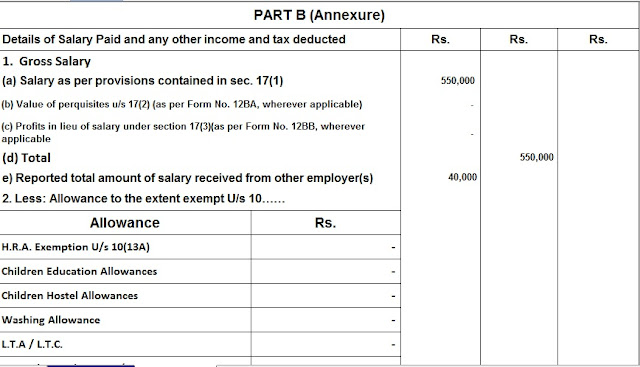The Finance Bill, 2021 proposes to withdraw the income tax exemption on interest on employees' contributions to the Employees Provident Fund (EPF) under certain circumstances. As a result of the proposed amendment, the tax deduction on interest income on the total amount of contributions made by the employee has been limited to Rs. These amendments to the introduction of tariffs on interest on PF contributions are subject to certain issues which are discussed in detail in this article. The amendment includes not only EPFE but also GPFO so that government employees can contribute their PF. Interest on EPF contributions is exempt from tax. 2.5 Lakh among the major amendments to the Union Budget 2021-22
Rationalization of tax-free income in provident funds
Finance Minister Mrs Nirmala Sitharaman announced in her budget speech during the presentation of the Union Budget 2021 that from April 1, 2021, Rs. Two and a half lakh taxes will be collected annually.
For the rationale of the tax deduction for income earned by high-income employees, it has been proposed to limit tax exemption for income of employees' contributions to various provident funds for annual contributions of various provident funds. Rs.2.5 Lacks. This limitation will only apply to contributions made on or after 01.04.2021, the budget statement said.
You may also, like- Automated Revised Income Tax Form 16 Part A&B and Part B for the F.Y.2020-21 as per new and old tax regime [This Excel Utility can prepare One by One Form 16 Part A&B and Part B]
As per last year's Finance Act, 2020, the government has made arrangements for the withdrawal of tax exemption and paid more than Rs. 4,000 / - to the employer's contribution in the account of recognized provident fund, national pension scheme (NPS) and additional funds of the concerned employee. A total of 750,000 people from the three funds are taxed in one year under the heading of ‘income from salary. This additional contribution from the employer will be treated as your / 17 (2) (vii).
This year’s budget did not change income tax rates in 2021 but did tax the interest earned on PF contributions by high-wage earners. However, interest tax-exempt on the contribution of employees in PF will be maintained till the total contribution in any financial year does not exceed Rs.500. 2,50,000. The ceiling of employee contribution in PF is Rs. 250,000 per annum indicates that the basic salary (including DA) must be at least Rs. 1,74,000 per month to qualify to pay tax on interest income Thus, an employee whose initial salary, including value-added allowance (DA), if any, exceeds Rs. The amount of interest he earns on his contribution to the PF above Rs. 1,744,000 / - per month should be subject to tax. 2,50,000 for a financial year contribution of Rs. 250,000, no tax will be involved and interest income for annual PF contribution will be Rs. 250,000 will be tax-free.
The Provident Fund is a retirement-cum-savings scheme. All funds other than the recognized provident fund are eligible for significant tax benefits, which is why the contribution of the provident fund is one of the most popular forms of retirement.
You may also, like- Automated Revised Income Tax Form 16 Part B for the F.Y.2020-21 as per new and old tax regime [This Excel Utility can prepare One by One Form 16 Part A&B and Part B]
What is the position of interest tax on PF contribution before amendment?
Under the existing provisions of the Income-tax Act, tax treatment exemptions, rebates and exemptions (EEE) of the Provident Fund i.e., monthly/periodic contributions are allowed as income deductions for tax purposes; Earnings encouraged on this contribution at the collection stage are also exempt from tax; And terminal facilities at the time of departure are not taxable in the hands of individual employees.
This is not the first time that the government has offered to pay PF tax. The Finance Bill, 201 proposed that tax be levied at the time of withdrawal of 75 0% contribution of EPF. The proposal was then withdrawn after a widespread outcry against the new tariffs.
However, this amendment may not face such a large response as it only affects the cream level of salaried employees.
Types of Provident Fund
For income tax purposes, provident funds are classified into:
Recognized Provident Fund (RPF) - A fund recognized by the Commissioner of Income Tax (CIT). EPFO's Provident Fund A scheme where the Employees' Provident Fund and Miscellaneous Provisions Act, 1952 applies to the Provident Fund recognized under the Income Tax Act, 1919.
If the employer operates the provident scheme by creating his own PF trust, the same recognition is required by the CIT.
You may also, like- Automated Revised Income Tax Form 16 Part A&B for the F.Y.2020-21 as per new and old tax regime [This Excel Utility can prepare at a time 50 Employees Form 16 Part A&B]
Section 2 (38) defines "provident fund" as a provident fund that has been recognized by the Principal Chief Commissioner or Chief Commissioner or Principal Commissioner or Commissioner in accordance with the rules of Part A of the Fourth Schedule and continues and the Employees' Provident Fund Act 1952 (1952). Includes a Provident Fund established under a project set up under 19).
2. Recognized Provident Fund (URPF) - A fund that is not recognized by the Commissioner of Income Tax.
3.Statutory Provident Fund (SPF) - This fund was established under the Provident Fund Act, 1925. It is primarily for government employees, universities, educational institutions, etc.
4. Public Provident Fund (PPF) - Employee-focused provident fund which is completely different from the above funds. Established under the PPF Public Provident Fund Act, 1968 and can be operated and operated by any person including self-employed persons.
You may also, like- Automated Income Tax All in One Value of Perquisite U/s17(2) in Excel Format


















